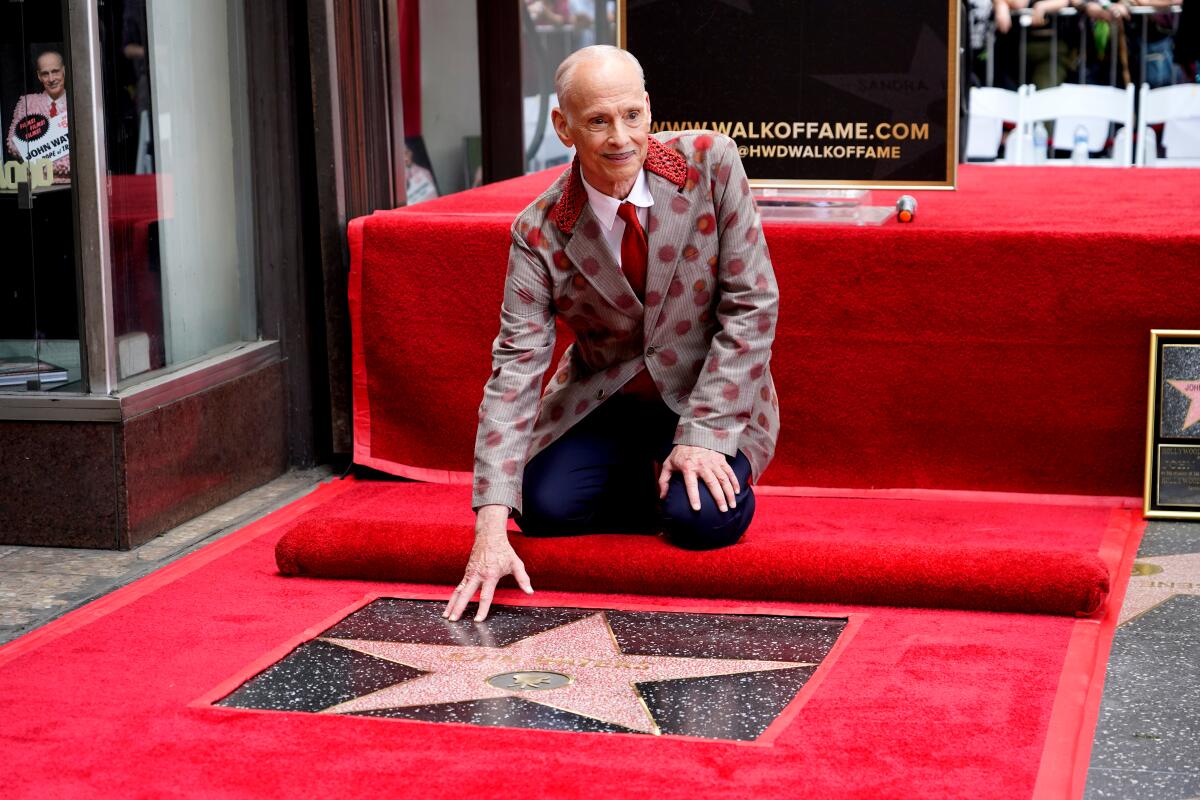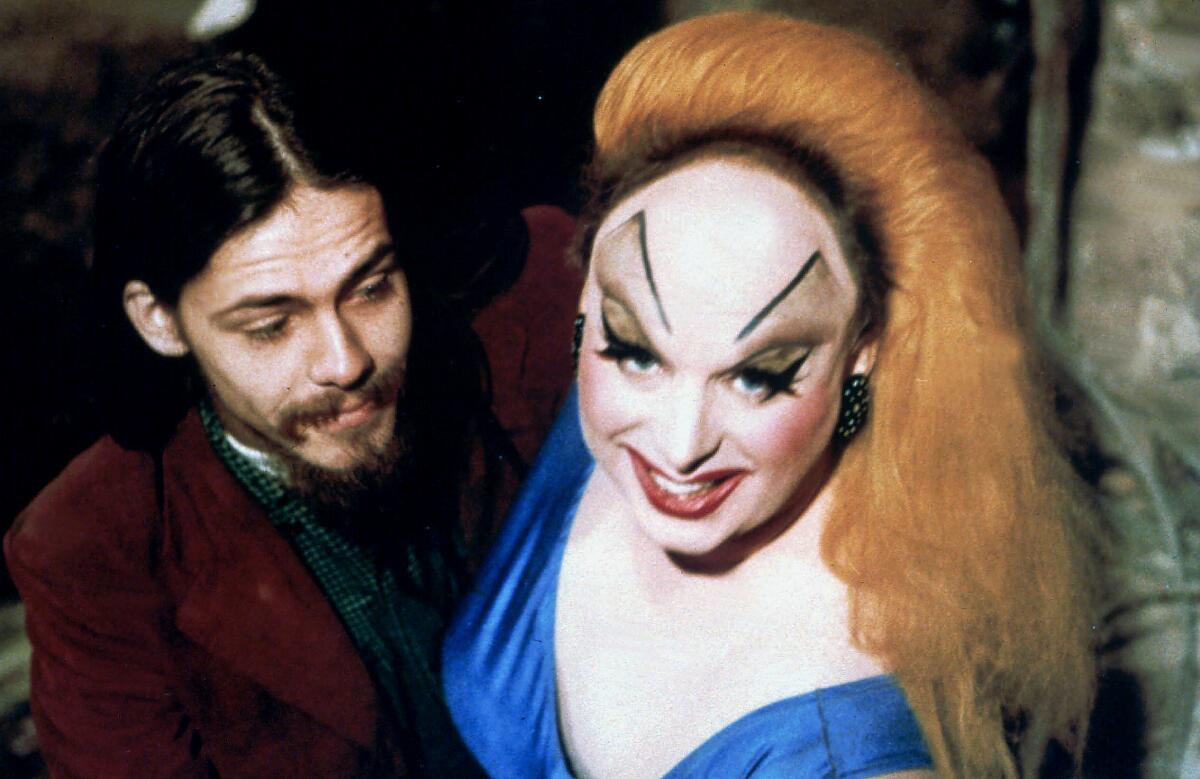Sign up for The Envelope
Get exclusive awards season news, in-depth interviews and columnist Glenn Whipp’s must-read analysis straight to your inbox.
You may occasionally receive promotional content from the Los Angeles Times.

For decades, film director and professional provocateur John Waters has been asked to explain himself and his movies, if not to censors, then to film critics, fans and book editors. That steady practice has crystallized into a belief system and a teachable aesthetic that has become — in our view — an ever-expanding handbook for life.
The man who calls himself a “filth elder” has emerged as a kind of prescient oracle whose principles are threaded through eight books, 12 feature films, speeches, artworks, one-man shows and since September, in “John Waters: Pope of Trash,” an exhibition devoted to his films at the Academy Museum of Motion Pictures. The museum’s exhibitions curator Jenny He and associate curator Dara Jaffe found working with him delightful and insightful.
“Every sentence he drops, you’re like, ‘We gotta write that down,’ not only because he is so witty, but because it is so enlightening, especially if you try to understand his career, and the culture as reflected in his career,” Jaffe says.
There are many life lessons to be derived from Waters’ vast body of work. Some can be gleaned from the museum exhibit, his films or books. Here are a few to keep in mind before your next viewing of “Hairspray,” or what he calls the trash trilogy of “Pink Flamingos,” “Female Trouble” and “Desperate Living.”
The 77-year-old Waters was kicked out of college for smoking weed, arrested several times and been cast, according to He, as a “purveyor of on-screen trash, taboo and filth.” Yet Waters has demonstrated a practically Puritan work ethic throughout his 60-year career. He had a thriving puppet show business at 12, made his first film at 17 and often wrote, directed, financed and edited his films. He’s been an in-demand actor and speaker and still performs a one-man show at least 40 times a year. “I was no slacker,” he has said. His discipline continues.
“Don’t try to call him between the hours of 9 to 12. He is writing, every day,” Jaffe says.
Waters’ movies frequently satirize social norms and good taste and imagine how the stifling suburbs can even drive a person to murder — the plot of 1994’s “Serial Mom.” The director’s obsessions around horror, fetish, drugs and scandal mirrors our own prurient fascination with sex, crime, gore and more. His 1972 “Pink Flamingos” is a catalog of grotesque, outrageous and profane situations that nevertheless endures and is celebrated as black comedy. In 2021, it was selected for preservation in the National Film Registry by the Library of Congress. Jeanine Basinger, who helped bring Waters’ collections to the Wesleyan University Ogden and Mary Louise Reid Cinema Archives, wrote in the exhibit catalog, “... over time, America was going to embrace John Waters in gratitude for relieving it of the burden of always pretending to be proper.”

Waters created a troupe of actors and crew members out of friends and neighbors in Baltimore, which became known as the Dreamlanders, including the diva drag queen Divine. They also represent a chosen family that can be essential in LGBTQ+ communities. The films reflect his wide embrace. “He is radically inclusive,” Jaffe says. Added He: “Even when he is satirizing or skewering a character, he is doing it from a place of love.” Dreamlanders also became lifelong friends. At the September installation ceremony for his star on the Hollywood Walk of Fame, Ricki Lake and Mink Stole spoke lovingly of their longtime collaborator. Friendship is essential, Waters said at the exhibit’s opening. “I don’t trust people who don’t have old friends. Something’s the matter with them.”

Despite censorship, low budgets, bad reviews and the deaths of several key Dreamlanders, Waters steadily worked on his films, and later, books and screenplays. In his 2019 book, “Mr. Know-It-All: The Tarnished Wisdom of a Filth Elder,” the director tracks his bumpy path to Hollywood with chapters such as “Accidentally Commercial” and “Sliding Back Down.” It’s full of advice for success seekers who may heed his call to find your voice, make noise and create a following. Waters has made a side career as a guru who freely dispenses wisdom about making art. At the exhibit’s opening, he said, “If you want to be in movies, see every movie. Even the bad ones. Read the trade papers. I got Variety when I was 14.”

Waters reads widely and has kept scrapbooks of articles that have inspired his work, particularly news of lurid crimes. The director is a curator’s dream. “We had a large portion of our [exhibition] checklist set just from our first visit to John’s house,” says He. “As soon as Dara and I walked into his house, the electric chair from ‘Female Trouble’ was right in front of us. It was stacked high with books. Immediately, Dara and I knew that was going in the show.” The leg of lamb prop from “Serial Mom” was on his desk in his office. His office and studio yielded many other illuminating artifacts, including fan letters and artworks. The curators also found items that cast and crew members kept for decades, including a mini leather jacket from “Cry-Baby” that was rescued from a house fire. Waters asked that every item connected to the academy exhibit be sent to his Wesleyan University archives. For other aspiring artists, Waters’ file-keeping and collecting are a great lesson. One day, you may turn from pariah to hero, and a museum will come knocking.
Sign up for The Envelope
Get exclusive awards season news, in-depth interviews and columnist Glenn Whipp’s must-read analysis straight to your inbox.
You may occasionally receive promotional content from the Los Angeles Times.